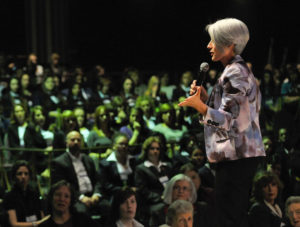
DIVING IN THE MOON
HONORING STORY, FACILITATING HEALING
©Eva Grayzel
The spotlight is on the speaker. The audience is observing their outward appearance,
gait, where they stand (behind the podium or in front of it). On some level, judgments
are being made before the speaker even opens their mouth.
I can guess what people think about me in the few moments after the introduction and
before I begin speaking: Is her white hair dyed or real? If it’s real, how old is she? Is her
outfit expensive? Does she really have a message worth hearing? Hopefully, once a
personal story is shared, those thoughts fall by the wayside and the audience stops
thinking. They start feeling. Listeners begin to feel their own response to your story.
Connections are being made.
As soon as I tell my personal story, the real 
me is revealed: my fears, my failures, my
truth. All judgments fall away as I intimately
describe a personal experience, sharing
universal feelings in which a listener can see
themselves.
“You are a survivor from the moment you are
diagnosed.” That is my first line. Then, I
soften my voice and begin to tell my story:
“I’ll never forget being wheeled away from my husband and mother at Mt. Sinai Hospital in NYC through large double gray doors bearing a diamond-shaped yellow sign reading “no visitors beyond this point.” Dressed in a thin cotton gown, on a cold metal gurney, I was wheeled into my parking spot alongside other patients coming in and out of surgery. Doctors and nurses were dashing around as I lay there at 8am for my 9am surgery slot.
At noon, I called over a nurse. “Excuse me, I’m sorry to bother you but my surgery is supposed to be 12 hours long and at this point, they’ll be operating on me at midnight. Can I reschedule for tomorrow?”
“Oh honey,” she said, “Don’t you worry about it, they do this AWL (NY accent)
the time? Now, do you want a magazine?” At that moment, the frustration
simmering deep inside began to erupt. Why didn’t my dentists know what was
staring at them on my lateral tongue? Why didn’t the oral surgeons question the
first biopsy, perform a second? I took my frustration out on this nurse: “Do you
know, I may never speak articulately again. I may never swallow normally; I may
not recognize my own face! And, you’re asking me if I want a magazine?”
She backed up, apologized, and walked away. I had nowhere to direct my
frustration but upwards. “How could you do this to me?”
I stopped myself remembering wise words of a friend who said, “When you
are angry, you’re weak.” I wanted to be strong! “Thank you for doing this to me
and not to my children.”
I lashed out again, “But why Stage IV?”
Again, I stopped myself. “Thank you for doctors who give me hope.”
“But why my tongue, out of all the parts of this body?” I had been a professional
performance artist specializing in interactive storytelling. “Why my tongue?”
Once again, I stopped myself. “Thank you for taking a third of my tongue and not
a third of my brain.” When I started to think this way, I felt this strength well up in
me. I looked my cancer in the eye and said, “You are not going to squat your
ugly face in this vessel, because I am going to fight.”
The story takes a different turn at this point depending on the audience. If it’s an
audience of doctors and nurses, I tell the clinical aspects of the extraordinary surgery
reconstructing a third of my tongue. For an audience of survivors, I validate feelings
during challenging times and articulate wisdom for moving forward. For a corporate
audience, the message focuses on challenges unanticipated and choices we make.
A recent and most memorable presentation was for nine hundred Healthcare
Occupations Students of America (HOSA) dressed in blue suits and white button-up
shirts who filled the Lancaster Host conference room, representing 85 schools across
Pennsylvania. Whether training as paramedics, nurses, dental hygienists, or radiology
technologists, these students were committed to a profession in healthcare. My goal
was to inspire these students to turn adversity into opportunity.
Afterwards, students approached me saying I touched them in a profound way. Others
had no words but offered a warm hand, an affirming hug, allowing a hesitant tear to fall.
Intellectualizing a message isn’t as motivating as feeling something deep in your gut.
It’s the emotional connection that is the seed for real change and growth.
In the lobby, other students stopped me to say, ‘Wow, you were really great.’ I thanked
them and then probed, asking what the take-away message was for them. Most said in
one way or another, ‘Never give up.’
The following morning, I gave a workshop on the power of story for the delegates from
each of the schools. These 90 students were well-spoken, hard-working and personable
potential leaders. Standing right in front of the half-circle, I began with, “We all make
judgments about others from appearances. But, when you heard my very personal
story, did you feel differently about me?” I paused and saw heads nodding. “Today, I
want to help you find the story you are meant to tell so judgments fall away and listeners
get a glimpse of the special person you are.”
I showed a slide listing values: Family, Education, Communication, Safety, Honesty,
and Health…. I asked everyone to choose one strongly held value. “Who would like to
share the value they chose? I asked.” The student whose hand I noticed first, said
‘Family.’ When I asked for more, she said the most important thing in the world is family.
I pushed for details about why family was the most important thing for her. With more
fire in her voice, she told us her 2-year old daughter gives her a reason to wake up
everyday and smile. When I asked if it was different from how she was raised, she
admitted it was just the opposite for her.
Ahhh, so her story emerges: ‘I am giving everything to my child that I wish I had growing
up. She gives me reason to smile, everyday. The joy I feel from providing a healthy
environment for my daughter motivates me to do the same for others.’
Sharing her story would make her stand out when it comes time to interview for a job.
Her story makes her memorable.
Another student said his top value was ‘Respect.’ His hand was shaky holding the
microphone as he told the group he was bullied on the playground. I asked him if he
could remember one specific moment when he was bullied. The voice of this six-foot,
well-built guy quivered as he painted a picture of himself at 8 years old when he
approached two boys during recess to play. The bigger kid said, “You are fat and ugly.
Leave.” He went over to a swing, alone, and began to feel a great darkness take over.
This is his story reframed: ‘I don’t want anyone to feel the pain of being shunned and
excluded as I was as a kid. The healthcare profession allows me to help every patient
feel cared about.’
Isn’t this the kind of person you want to include on your team?
One last story was memorable. The student chose the value ‘Communication’ and told
us that when her grandparents died, no one loved her, not even her parents. One day at
school, she shared her suicidal feelings with a teacher. I’ll never forget the way she
looked down and softened her voice saying, “I think this teacher really cared about me.”
Her story reframed would be: “At one time in my life, I felt there was nothing to live for.
The act of communicating my feelings to a schoolteacher saved me. I want to be like my
teacher and help others communicate their health concerns so they can get the care
they need.’
Think of all the websites you’ve visited in search of a doctor, lawyer, real estate agent,
contractor or charity. Often, one visits the “About” page. People want to know more
about the kind of person behind the business. They want to have a sense of what the
patient or client experience will look like. However, most biographies only contain
information about education, mention and accolades, memberships and conclude with a
line or two about hobbies. Does this information really engage a reader?
Think of all the sales people you’ve encountered. Would you be more likely to buy their
service or product if you knew what kind of person they are or if you knew their values
or work ethic? Telling your story has a subconscious effect on a listener. It says, ‘I trust
you with my story.’ It can trigger an emotional response that often begins the process of
sharing and trust.
Every business, even the business of storytelling, is based on building relationships.
Relationships are built on trust. Story builds trust. Story creates a connection through
mutual values or experiences. A story that evokes emotion and imparts wisdom will
leave a lasting impression. Story ignites ideas and changes perspectives. Story is a gift.
 Eva Grayzel, a nationally recognized Master Storyteller and expert on interactive storytelling techniques, enriches learning through the power of story. A late-stage oral cancer diagnosis almost stole her ability to continue working. She performed her survival story, ‘Tongue-Tied’ Off-Broadway, founded Six-Step Screening, published two books to empower children about cancer with coping skills and communication strategies and developed a fill-in booklet, ‘My Story Legacy’ – personal stories for future generations. Her signature stories are recorded on ‘A Story A Day.’ She shares her model for crafting powerful stories in keynotes, workshops and private coaching.
Eva Grayzel, a nationally recognized Master Storyteller and expert on interactive storytelling techniques, enriches learning through the power of story. A late-stage oral cancer diagnosis almost stole her ability to continue working. She performed her survival story, ‘Tongue-Tied’ Off-Broadway, founded Six-Step Screening, published two books to empower children about cancer with coping skills and communication strategies and developed a fill-in booklet, ‘My Story Legacy’ – personal stories for future generations. Her signature stories are recorded on ‘A Story A Day.’ She shares her model for crafting powerful stories in keynotes, workshops and private coaching.
Talk4Hope.com ~ evagrayzel.com ~ sixstepscreening.org ~ 610-258- 3763
